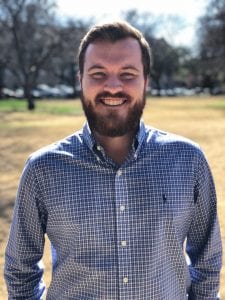 Since last summer, the Operational Excellence website has been featuring a series of staff spotlights: stories about staff members who’ve taken on new leadership roles since the implementation of OE2C and are helping bring more innovation and efficiency to campus operations. Read more SMU staff spotlights
Since last summer, the Operational Excellence website has been featuring a series of staff spotlights: stories about staff members who’ve taken on new leadership roles since the implementation of OE2C and are helping bring more innovation and efficiency to campus operations. Read more SMU staff spotlights
Brian Cook is not only SMU’s RFP coordinator, but also an entrepreneur. He earned a B.B.A. in finance and accounting from Stephen F. Austin State University and, while completing his M.B.A. there, he launched his own music entertainment business.
His entrepreneurial experience also serves him in his current role as a purchasing agent for SMU and as the procurement card administrator and coordinator for all requests for proposal (RFPs) for the University. “I am responsible for approving purchase requisitions in various spending categories, ordering and maintaining the many credit cards held and used by SMU faculty and staff for business and travel expenses, and overseeing the University’s annual RFP calendar,” said Cook. “I also help lead or support any RFP processes completed by the University in order to select preferred or exclusive vendors for various goods and services.”
In his work to support the selection of exclusive vendors, Cook makes a major contribution to the work of the Operational Excellence initiative. “I have learned how important good planning is and that the most effective way to achieve maximum efficiency is to develop strong processes and procedures built on feedback from all parties involved,” he said.
Cook enjoys ensuring consistency in procurement operations and accurately reporting and tracking activity. “But my favorite part of my current position is getting to interact with many different SMU faculty and staff members who work in numerous different areas across campus,” said Cook. “I get to learn about their individual roles and work together with them and the University’s vendors to develop creative and efficient ways to meet their needs while helping to achieve the University’s overall goals.”
Although he only joined the SMU purchasing team in fall 2016, he has already scored several significant gains for the University, including overseeing the RFPs for security and parking services and for event services. “Both of these were very large undertakings that required many different areas and personnel across campus to work together,” said Cook. “They were only successful because of the strong precedent set by previous RFP initiatives related to OE2C prior to my joining the University. It is really cool to get to see the bottom line savings impact of the work that was put into these initiatives.”
Cook’s contributions to SMU’s bottom line are far from complete. “I hope to help streamline the SMU P-card process and create and maintain a central RFP calendar so that the University can ensure it is evaluating its vendors and contracts on a consistent and timely basis,” he said. “My goal is to help make SMU’s purchasing and procurement operations as smooth and efficient as possible.”


